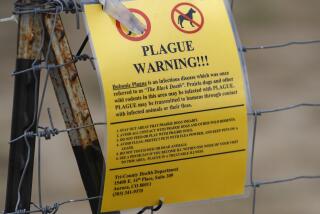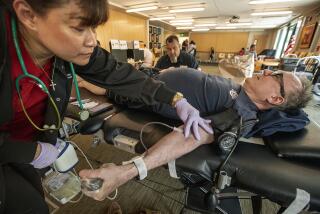Killer Diseases Infect World Blood Banks : Transfusions: The alarm is sounded on wide-ranging maladies, many potentially debilitating or fatal.
- Share via
The Persian Gulf War flashed yet another warning that international travel can threaten one of the world’s most precious commodities: human blood.
U.S. military and blood bank officials late last year banned donations from the more than 500,000 Americans who served in the Persian Gulf. Troops there in 1990 and 1991 were exposed to leishmaniasis, a parasitic disease that is spread by the bite of sand flies and may be transmitted in blood.
The condition, potentially fatal unless treated, is among a number of little-known blood-borne diseases with proclivities for specific regions.
Some, including Chagas’ disease in Latin America, are also a source of concern in the United States.
Others bear names such as Crimean-Congo fever and Mediterranean fever, suggestive of their origin or occurrence. Although rare in the United States, they rank as important transfusion-associated risks in other countries.
Leishmaniasis now has joined Chagas’ disease, malaria and a few other conditions on the worry list. It actually is a group of maladies caused by a microscopic single-celled animal, Leishmania.
Symptoms of the disease (named for Dr. William B. Leishman, a British army surgeon) include sores on the skin, irritation of mucus membranes and potentially serious damage to internal organs.
Physicians found that seven U.S. soldiers who served in the Persian Gulf developed visceral leishmaniasis, a form of the disease in which protozoa invade the bloodstream and bone marrow. This led to concern over possible transmission of the parasite in donated blood.
“All indications are that the blood supply is safe from this disease,” said Dr. William Sherwood, acting senior vice president for biomedical services at the American Red Cross. “There have been no reported cases of Leishmania passed by blood transfusion in the United States in the last 50 years.”
Every year in this country, about 20 million units of whole blood and blood components--red cells, plasma and platelets--are transfused into 4 million patients.
The U.S. supply of whole blood depends on about 8 million volunteer donors, who give without payment. The Red Cross collects about half the blood. Independent blood banks, affiliated with the American Assn. of Blood Banks, collect the rest.
The military operates its own blood banks, but depends on civilians for supplemental supplies.
Commercial “plasma centers” form the other major component of the blood-supply system. They pay donors for plasma, which is used instead of whole blood to treat some diseases.
Potential donors have grown more reluctant for several reasons, including irrational fears that giving blood carries a risk of catching the AIDS (acquired immune deficiency syndrome) virus.
Experts emphasize that the risk is nonexistent. Blood banks collect blood under sterile conditions, not with the dirty needles that spread AIDS and other diseases among intravenous drug abusers.
But efforts to make the blood supply safer also have made the donor pool smaller. Blood banks are rejecting more potential givers who are at risk of carrying certain diseases. Donated blood must pass a battery of tests for human immunodeficiency virus (HIV), the cause of AIDS, and for hepatitis, syphilis and other infectious diseases.
Spokesmen for the U.S. Food and Drug Administration, which regulates blood banks, say the procedures have made transfusions safer than ever.
In the 1960s, about one in three transfusion recipients developed hepatitis, a potentially serious liver disorder. Today, hepatitis occurs in only about one in every 100 recipients.
“The chances of contracting the AIDS virus from a blood transfusion are now estimated to be rarer than dying from an adverse reaction to penicillin,” the FDA’s Bradford Wind Stone says.
Chagas’ disease, like leishmaniasis, is treatable but potentially fatal. Similar to African sleeping sickness, it is a special worry in U.S. blood banks. It is spread to humans by bloodsucking bugs that deposit contaminated feces in eyes, mouth or cuts.
“Transfusion-associated Chagas’ disease is a serious public health problem in Central and South America,” Dr. P.R. Kerndt, an epidemiologist with the Centers for Disease Control in Atlanta, reported in a 1991 study. “With the recent influx of immigrants from Chagas’ disease-endemic areas, concern about the risk of disease from blood transfusion has increased in the United States.”
More to Read
Sign up for Essential California
The most important California stories and recommendations in your inbox every morning.
You may occasionally receive promotional content from the Los Angeles Times.










